Abstract
Blood lymphocytes and rectal plasma cells have been studied in patients with ulcerative colitis taking part in a double-blind trial of treatment with azathioprine. Treatment for 1 year resulted in a modest fall in blood lymphocyte count, with little change in neutrophils or platelets. There was no major change in the proportions of circulating T and B lymphocytes, suggesting that the number of such cells per millilitre of blood fell in proportion to the change in lymphocyte count. The number of plasma cells in the rectal lamina propria was reduced to a mean less than half that of the control patient group. Blood K-cell cytotoxic activity fell at least 25-fold after 1 year's treatment. PHA-induced cytotoxicity was also reduced, but less consistently. Reduced K-cell activity is interpreted as reflecting depletion of effector cells from the circulation. The fall in lymphocyte count, K-cell activity and gut plasma cells was slow, indicating continuous inhibition of lymphopoiesis or differentiation throughout the trial period. Thus, azathioprine has some immunosuppressive effects which develop only after prolonged treatment. The clinical results of the trial did not show a major beneficial effect of azathioprine in the treatment of ulcerative colitis, nor were there clear correlations between the results of lymphocyte assays and clinical response in individual patients.
Full text
PDF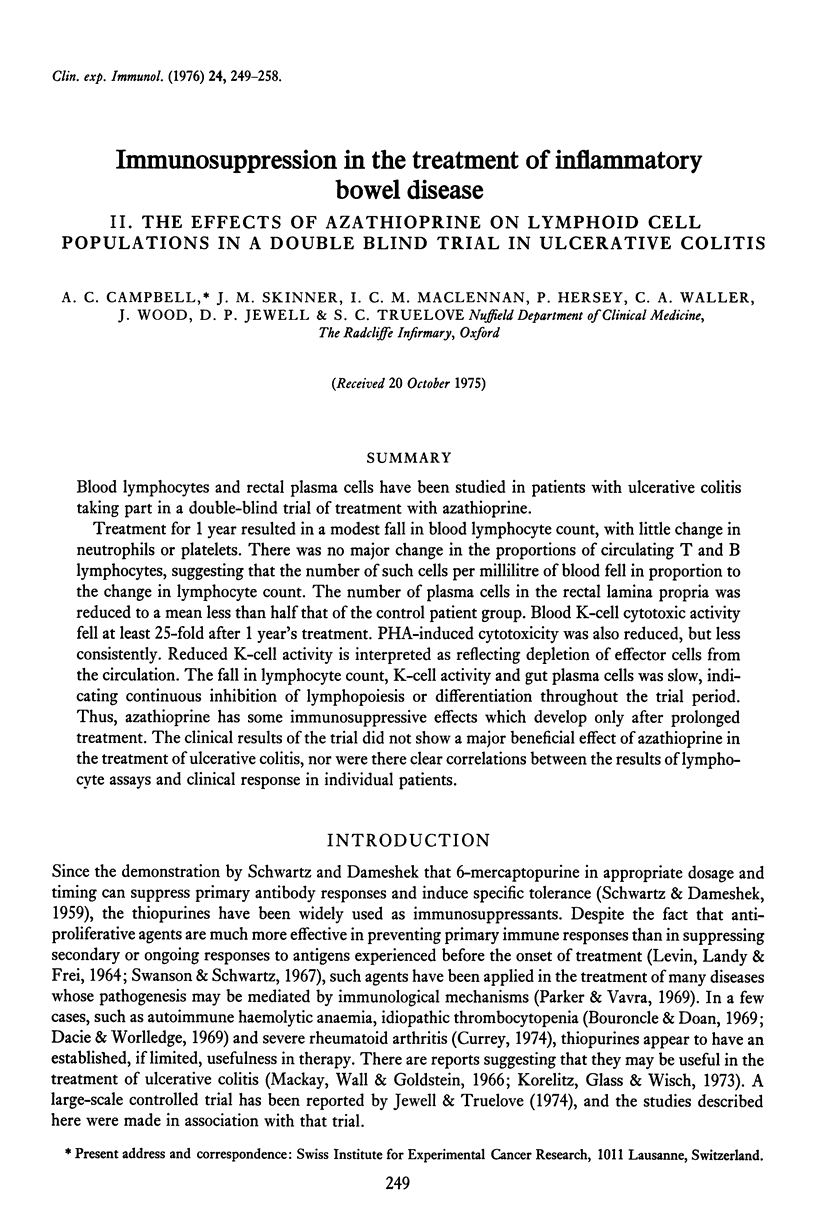
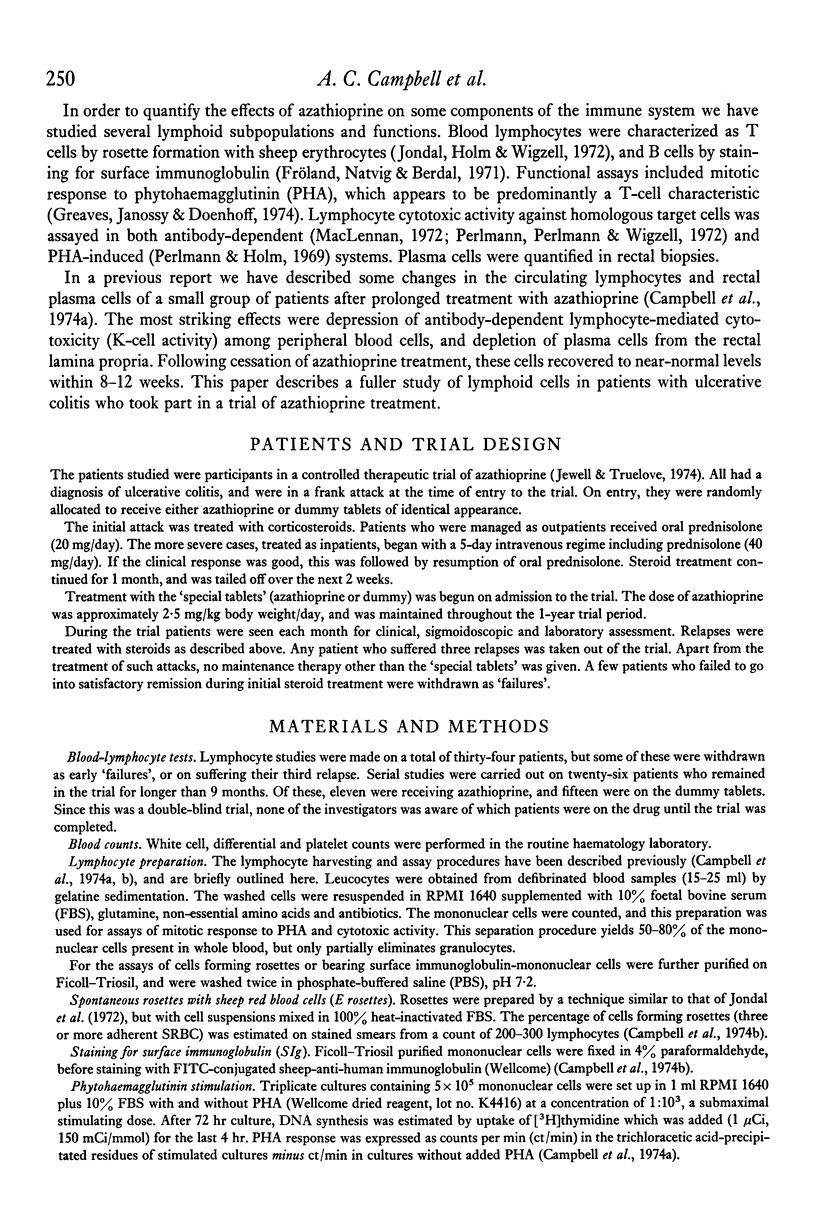
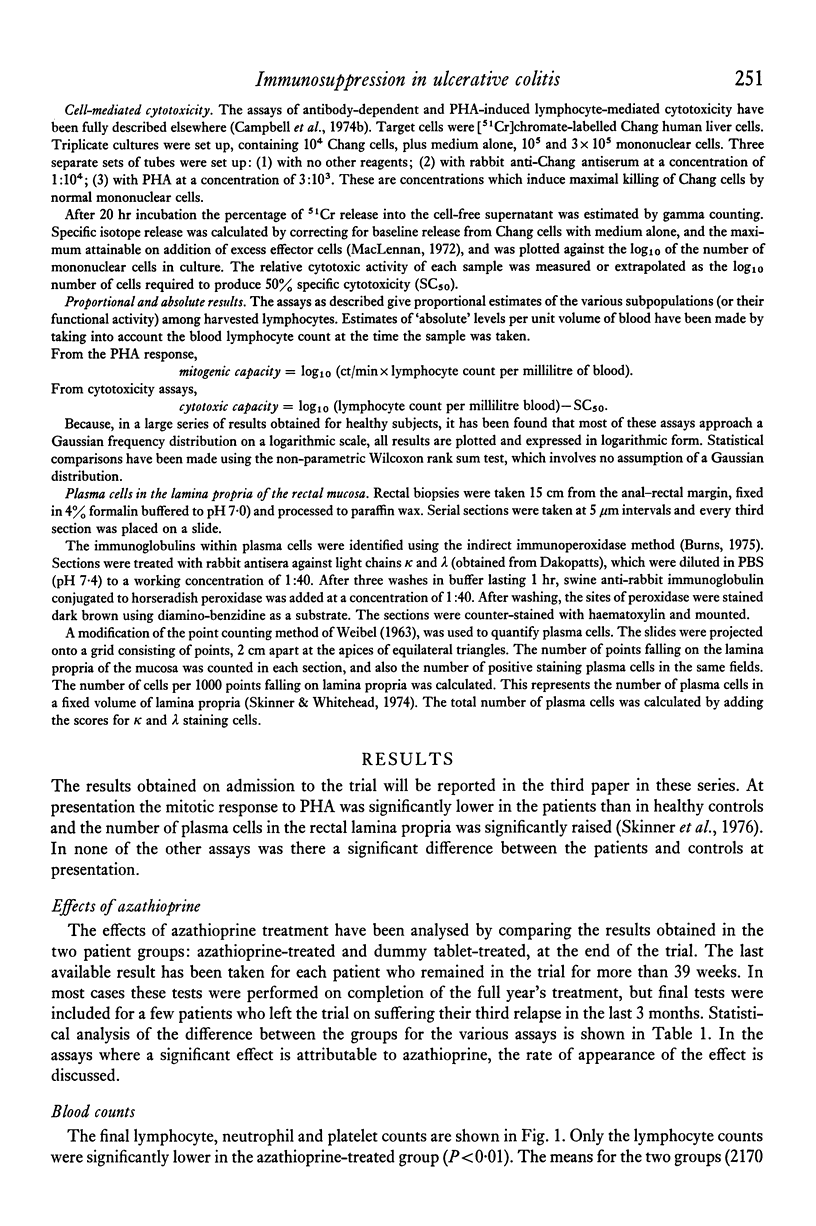
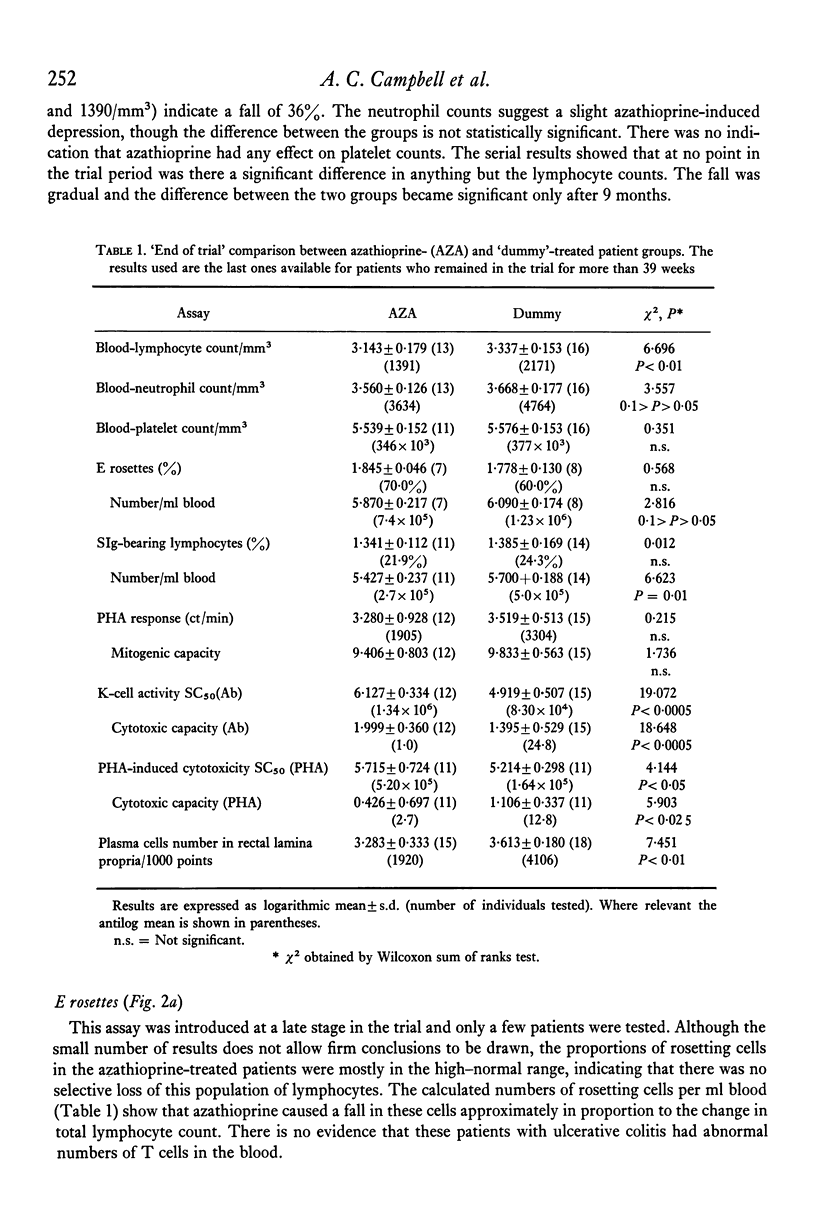
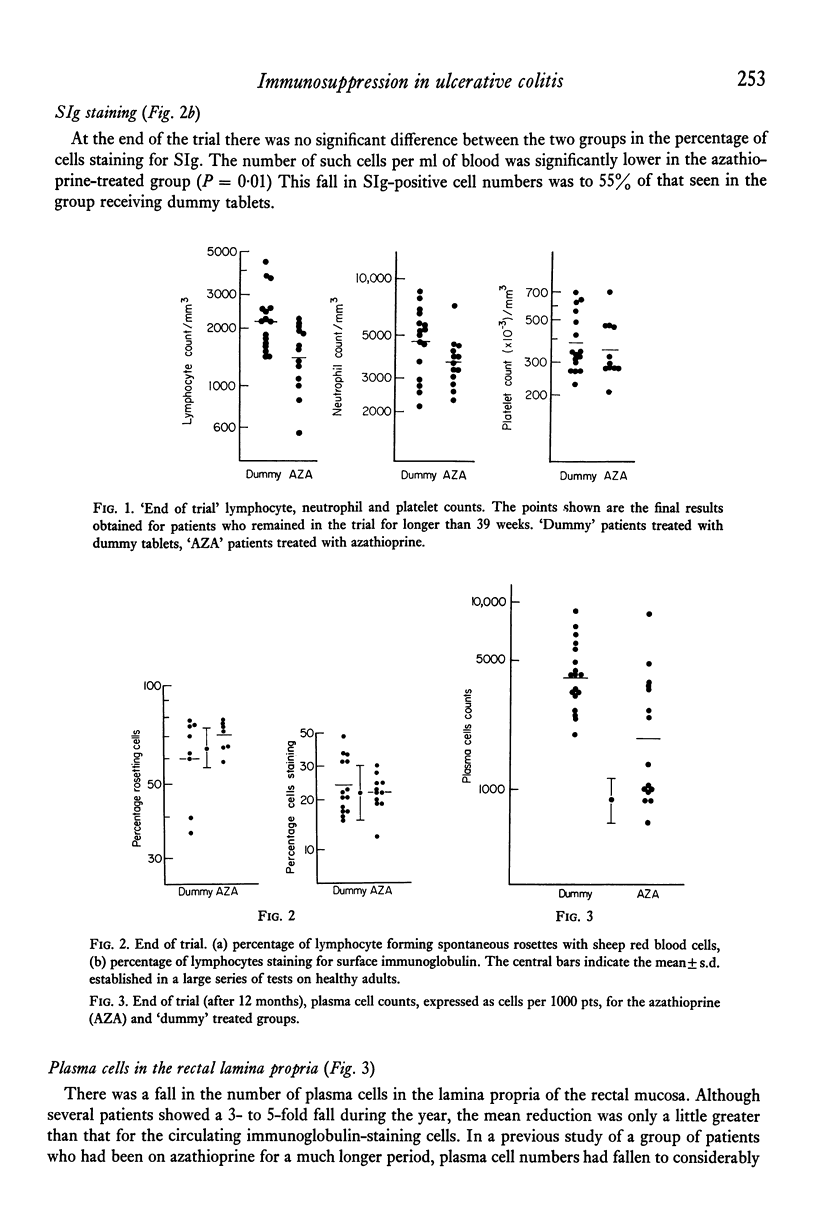
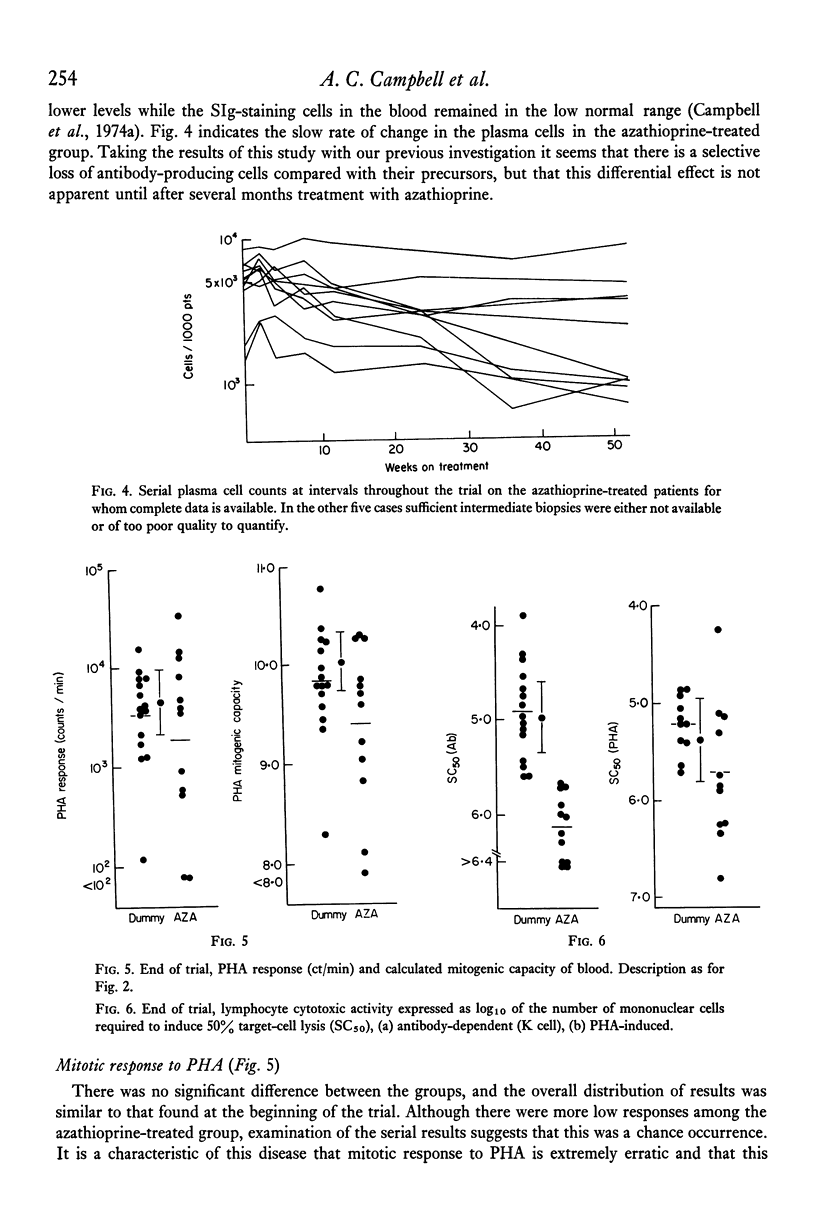
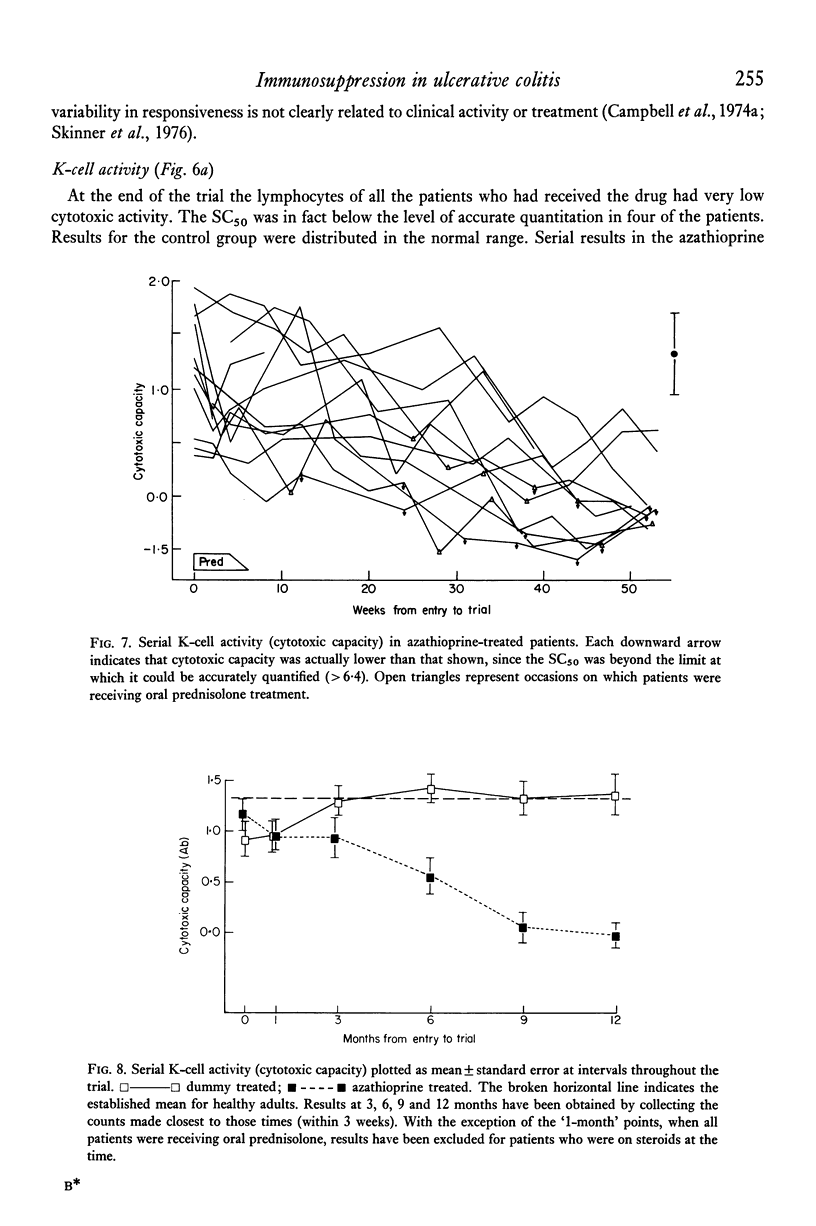
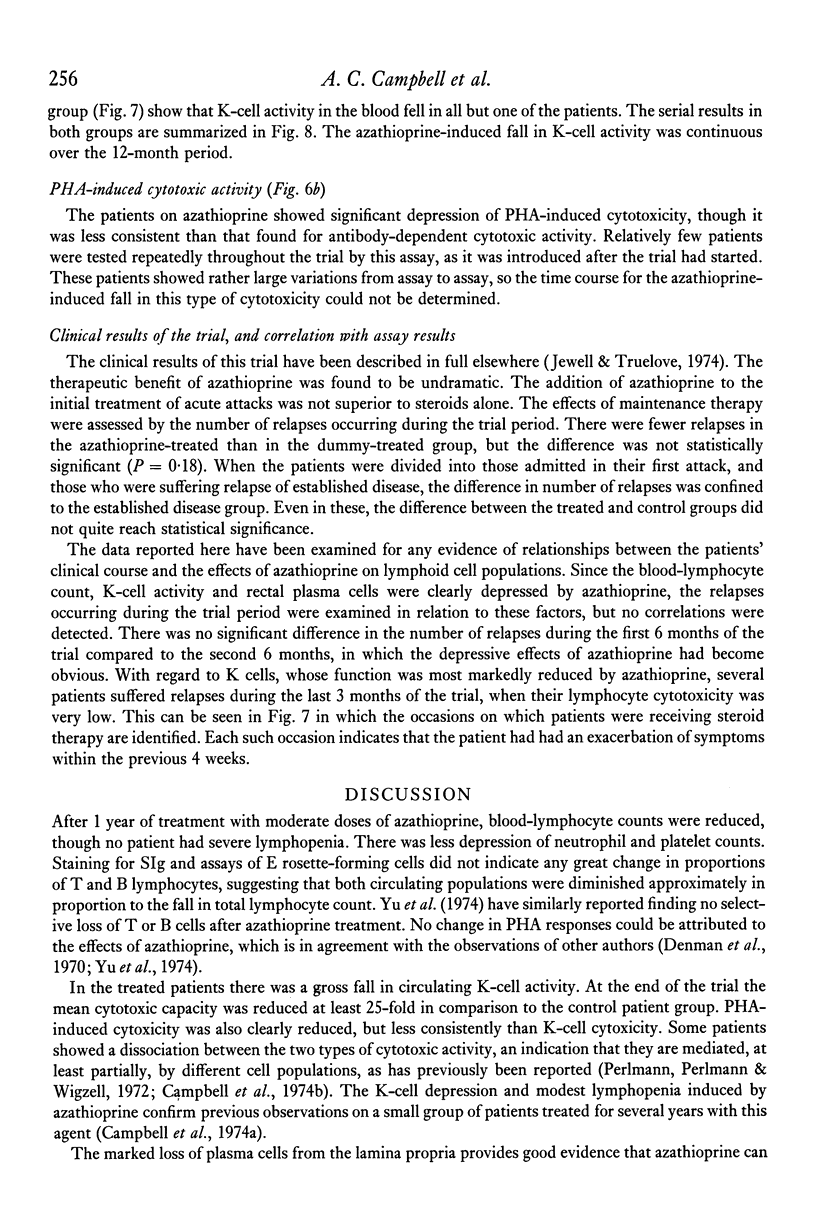
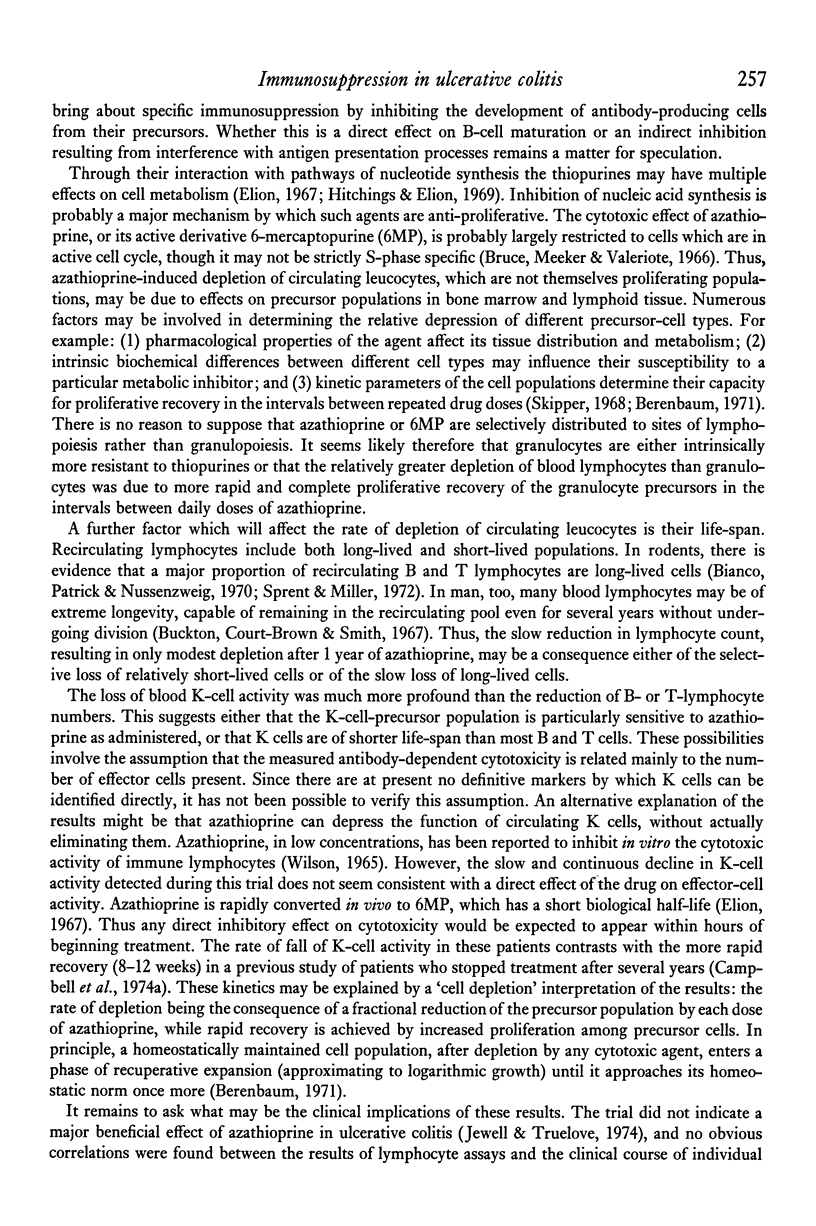
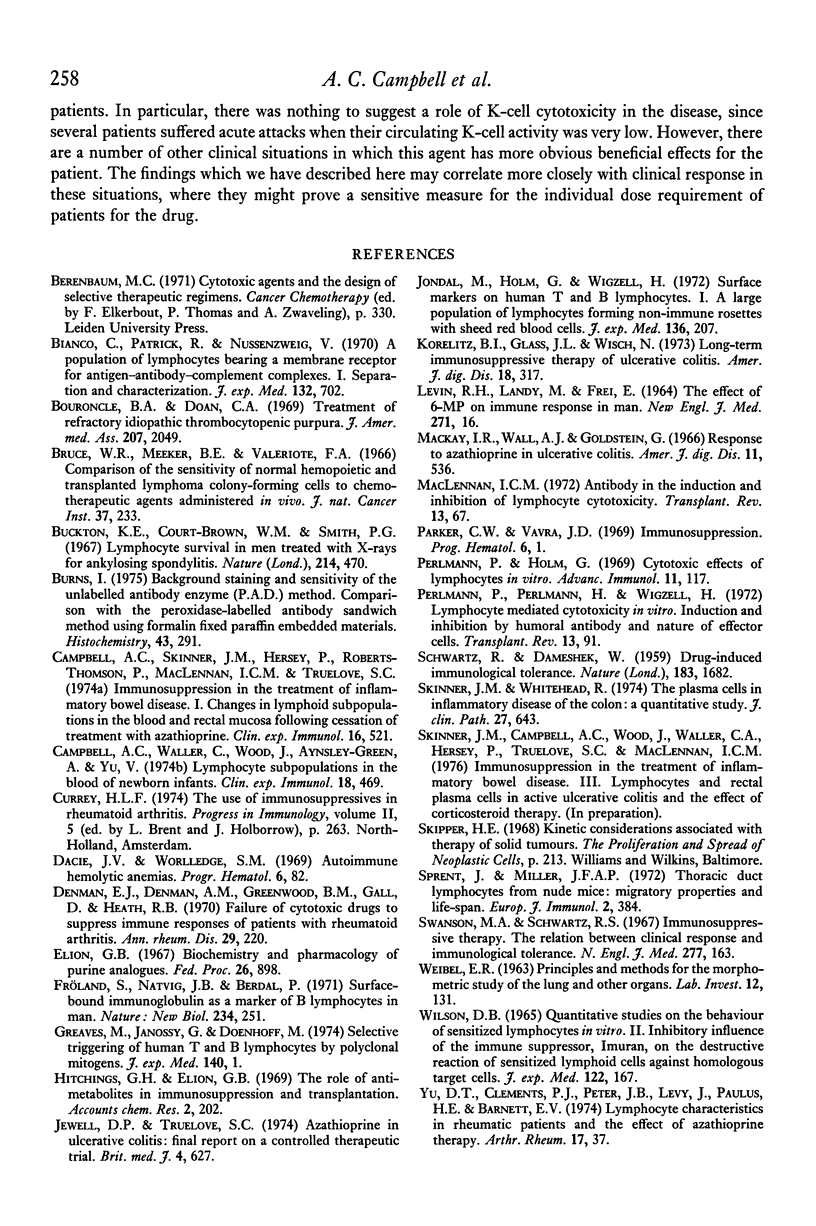
Selected References
These references are in PubMed. This may not be the complete list of references from this article.
- Bianco C., Patrick R., Nussenzweig V. A population of lymphocytes bearing a membrane receptor for antigen-antibody-complement complexes. I. Separation and characterization. J Exp Med. 1970 Oct 1;132(4):702–720. doi: 10.1084/jem.132.4.702. [DOI] [PMC free article] [PubMed] [Google Scholar]
- Bouroncle B. A., Doan C. A. Treatment of refractory idiopathic thrombocytopenic purpura. JAMA. 1969 Mar 17;207(11):2049–2052. [PubMed] [Google Scholar]
- Bruce W. R., Meeker B. E., Valeriote F. A. Comparison of the sensitivity of normal hematopoietic and transplanted lymphoma colony-forming cells to chemotherapeutic agents administered in vivo. J Natl Cancer Inst. 1966 Aug;37(2):233–245. [PubMed] [Google Scholar]
- Buckton K. E., Brown W. M., Smith P. G. Lymphocyte survival in men treated with x-rays for ankylosing spondylitis. Nature. 1967 Apr 29;214(5087):470–473. doi: 10.1038/214470a0. [DOI] [PubMed] [Google Scholar]
- Burns J. Background staining and sensitivity of the unlabelled antibody-enzyme (PAP) method. Comparison with the peroxidase labelled antibody sandwich method using formalin fixed paraffin embedded material. Histochemistry. 1975 Jun 5;43(3):291–294. doi: 10.1007/BF00499711. [DOI] [PubMed] [Google Scholar]
- Campbell A. C., Skinner J. M., Hersey P., Roberts-Thomson P., MacLennan I. C., Truelove S. C. Immunosuppression in the treatment of inflammatory bowel disease. I. Changes in lymphoid sub-populations in the blood and rectal mucosa following cessation of treatment with azathioprine. Clin Exp Immunol. 1974 Apr;16(4):521–533. [PMC free article] [PubMed] [Google Scholar]
- Campbell A. C., Waller C., Wood J., Aynsley-Green A., Yu V. Lymphocyte subpopulations in the blood of newborn infants. Clin Exp Immunol. 1974 Dec;18(4):469–482. [PMC free article] [PubMed] [Google Scholar]
- Dacie J. V., Worlledge S. M. Auto-immune hemolytic anemias. Prog Hematol. 1969;6:82–120. [PubMed] [Google Scholar]
- Denman E. J., Denman A. M., Greenwood B. M., Gall D., Heath R. B. Failure of cytotoxic drugs to suppress immune responses of patients with rheumatoid arthritis. Ann Rheum Dis. 1970 May;29(3):220–231. doi: 10.1136/ard.29.3.220. [DOI] [PMC free article] [PubMed] [Google Scholar]
- Elion G. B. Symposium on immunosuppressive drugs. Biochemistry and pharmacology of purine analogues. Fed Proc. 1967 May-Jun;26(3):898–904. [PubMed] [Google Scholar]
- Fröland S., Natvig J. B., Berdal P. Surface-bound immunoglobulin as a marker of B lymphocytes in man. Nat New Biol. 1971 Dec 22;234(51):251–252. doi: 10.1038/newbio234251a0. [DOI] [PubMed] [Google Scholar]
- Greaves M., Janossy G., Doenhoff M. Selective triggering of human T and B lymphocytes in vitro by polyclonal mitogens. J Exp Med. 1974 Jul 1;140(1):1–18. doi: 10.1084/jem.140.1.1. [DOI] [PMC free article] [PubMed] [Google Scholar]
- Jewell D. P., Truelove S. C. Azathioprine in ulcerative colitis: final report on controlled therapeutic trial. Br Med J. 1974 Dec 14;4(5945):627–630. doi: 10.1136/bmj.4.5945.627. [DOI] [PMC free article] [PubMed] [Google Scholar]
- Jondal M., Holm G., Wigzell H. Surface markers on human T and B lymphocytes. I. A large population of lymphocytes forming nonimmune rosettes with sheep red blood cells. J Exp Med. 1972 Aug 1;136(2):207–215. doi: 10.1084/jem.136.2.207. [DOI] [PMC free article] [PubMed] [Google Scholar]
- Korelitz B. I., Glass J. L., Wisch N. Long-term immunosuppressive therapy of ulcerative colitis. Continuation of a personal series. Am J Dig Dis. 1973 Apr;18(4):317–322. doi: 10.1007/BF01070993. [DOI] [PubMed] [Google Scholar]
- LEVIN R. H., LANDY M., FREI E., 3rd THE EFFECT OF 6-MERCAPTOPURINE ON IMMUNE RESPONSE IN MAN. N Engl J Med. 1964 Jul 2;271:16–22. doi: 10.1056/NEJM196407022710103. [DOI] [PubMed] [Google Scholar]
- MacLennan I. C. Antibody in the induction and inhibition of lymphocyte cytotoxicity. Transplant Rev. 1972;13:67–90. doi: 10.1111/j.1600-065x.1972.tb00060.x. [DOI] [PubMed] [Google Scholar]
- Mackay I. R., Wall A. J., Goldstein G. Response to azathioprine in ulcerative colitis. Report of 7 cases. Am J Dig Dis. 1966 Jul;11(7):536–545. doi: 10.1007/BF02233565. [DOI] [PubMed] [Google Scholar]
- Parker C. W., Vavra J. D. Immunosuppression. Prog Hematol. 1969;6:1–81. [PubMed] [Google Scholar]
- Perlmann P., Perlmann H., Wigzell H. Lymphocyte mediated cytotoxicity in vitro. Induction and inhibition by humoral antibody and nature of effector cells. Transplant Rev. 1972;13:91–114. doi: 10.1111/j.1600-065x.1972.tb00061.x. [DOI] [PubMed] [Google Scholar]
- SCHWARTZ R., DAMESHEK W. Drug-induced immunological tolerance. Nature. 1959 Jun 13;183(4676):1682–1683. doi: 10.1038/1831682a0. [DOI] [PubMed] [Google Scholar]
- Skinner J. M., Whitehead R. The plasma cells in inflammatory disease of the colon: a quantitative study. J Clin Pathol. 1974 Aug;27(8):643–646. doi: 10.1136/jcp.27.8.643. [DOI] [PMC free article] [PubMed] [Google Scholar]
- Sprent J., Miller J. F. Thoracic duct lymphocytes from nude mice: migratory properties and life-span. Eur J Immunol. 1972 Aug;2(4):384–387. doi: 10.1002/eji.1830020420. [DOI] [PubMed] [Google Scholar]
- Swanson M. A., Schwartz R. S. Immunosuppressive therapy. The relation between clinical response and immunologic competence. N Engl J Med. 1967 Jul 27;277(4):163–170. doi: 10.1056/NEJM196707272770401. [DOI] [PubMed] [Google Scholar]
- WEIBEL E. R. Principles and methods for the morphometric study of the lung and other organs. Lab Invest. 1963 Feb;12:131–155. [PubMed] [Google Scholar]
- WILSON D. B. QUANTITATIVE STUDIES ON THE BEHAVIOR OF SENSITIZED LYMPHOCYTES IN VITRO. II. INHIBITORY INFLUENCE OF THE IMMUNE SUPPRESSOR, IMURAN, ON THE DESTRUCTIVE REACTION OF SENSITIZED LYMPHOID CELLS AGAINST HOMOLOGOUS TARGET CELLS. J Exp Med. 1965 Jul 1;122:167–172. doi: 10.1084/jem.122.1.167. [DOI] [PMC free article] [PubMed] [Google Scholar]
- Yy D. T., Clements P. J., Peter J. B., Levy J., Paulus H. E., Barnett E. V. Lymphocyte characteristics in rheumatic patients and the effect of azathioprine therapy. Arthritis Rheum. 1974 Jan-Feb;17(1):37–45. doi: 10.1002/art.1780170107. [DOI] [PubMed] [Google Scholar]


